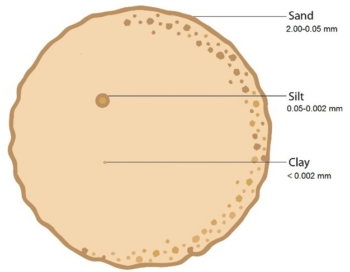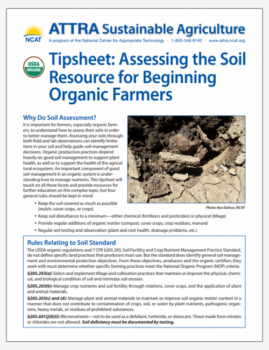Tipsheet: Assessing the Soil Resource for Beginning Organic Farmers
By Rex Dufour, NCAT Agriculture Specialist
Why Do Soil Assessment?
It is important for farmers, especially organic farmers, to understand how to assess their soils in order to better manage them. Assessing your soils through both field and lab observations can identify limitations in your soil and help guide soil-management decisions. Organic production practices depend heavily on good soil management to support plant health, as well as to support the health of the agricultural ecosystem. An important component of good soil management in an organic system is understanding how to manage nutrients. This tipsheet will touch on all these facets and provide resources for further education on this complex topic, but four general rules should be kept in mind:
- Keep the soil covered as much as possible (mulch, cover crops, or crops)
- Keep soil disturbance to a minimum—either chemical (fertilizers and pesticides) or physical (tillage)
- Provide regular additions of organic matter (compost, cover crops, crop residues, manure)
- Regular soil testing and observation (plant and root health, drainage problems, etc.)
Rules Relating to Soil Standard
The USDA organic regulations and 7 CFR §205.203, Soil Fertility and Crop Nutrient Management Practice Standard,
do not define specific land practices that producers must use. But the standard does identify general soil management and environmental protection objectives. From these objectives, producers and the organic certifiers they work with must determine whether specific farming practices meet the National Organic Program (NOP) criteria.§205.203(a): Select and implement tillage and cultivation practices that maintain or improve the physical, chemical, and biological condition of soil and minimize soil erosion.
§205.203(b): Manage crop nutrients and soil fertility through rotations, cover crops, and the application of plant
and animal materials.
§205.203(c) and (d): Manage plant and animal materials to maintain or improve soil organic matter content in a
manner that does not contribute to contamination of crops, soil, or water by plant nutrients, pathogenic organisms, heavy metals, or residues of prohibited substances.
§205.601(j)(6)(i): Micronutrients—not to be used as a defoliant, herbicide, or desiccant. Those made from nitrates
or chlorides are not allowed. Soil deficiency must be documented by testing.
Basic Steps to Assess Your Soil |
|
| Assessment Step | Assessment Activity |
| Establish baseline information | Research the history of crops/fertilizers/pesticides used on the soil and other soil management practices (heavy machinery, ripping, etc.). Get soil map for farm location that shows soil types (WebSoilSurvey). Using soil map, take samples of the soils for analysis. |
| Soil observation* | Look for ponding, crusting, places where plants are consistently unthrifty, and other signs the soil is not functioning. Test for compaction layer where ponding occurs. Spend time in the field during prolonged dry or wet weather to observe the soil and plant health. |
| Develop soil management plan | Use your soil tests as a guide to develop a plan to manage your soils. Most soils are low in organic matter and various other nutrients. A soil test documenting deficiency of micronutrients is required by the NOP in order to apply micronutrients. |
| Soil management | Good soil management is as much an art as it is a science. Understanding what your soil needs is a first step and will help in deciding which combinations of compost, crop rotations, cover crops, manure, mulches, tillage, proper fertilizers & rates to use to bring your soil to optimum function. Don’t expect instant results |
| Soil monitoring | Observations of plant health and other attributes of the soil outlined below will tell the grower if soil function is improving or not. Soil tests done every year, or at least every other year, will help indicate trends in soil quality. Annual inspections by your organic certifier will help highlight any concerns related to soil or nutrient management. |
| Special case: urban soils | Urban soils should always be tested for heavy metal contamination before any planting is done, and they should be tested for the nutrient status of the soil. Samples for heavy metal testing should be taken close to buildings and along streets or sidewalks—these are the likely “hotspots” for lead contamination from paint or leaded gasoline. See ATTRA’s Start a Farm in the City, pages 9-13, for more information about testing and mitigation. |
*Farmers’ observations are an important component of soil assessment. There are additional tools, such as soil maps and soil testing, which can help farmers understand how to improve their soils’ function. Most of the criteria of a good soil listed below can be observed by the farmer:
-

Figure 1. Relative size comparison between sand, silt, and clay of the fine earth fraction. Source: www. nature.com
feels soft and crumbles easily
- drains well and warms up quickly in the spring
- does not crust after planting
- soaks up heavy rains with little runoff
- stores moisture for drought periods
- has few clods and no hardpan
- resists erosion and nutrient loss
- supports high populations of soil organisms
- has a rich, earthy smell
- does not require increasing inputs for high yields
- produces healthy, high-quality crops
Soil is made up of different sizes of minerals—sand, silt and clay—as well as organic matter and spaces for water and air. The function of soil high in either sand or clay content can be improved with additions of organic matter.
Sandy soil: Drains well, but doesn’t store water or nutrients well. May have nematode problems.
Silty soil: Generally considered to be quite fertile, and drains more readily than clay due to larger-size particles.
Clay soil: Generally higher in nutrients and ability to store water, but drains slowly, and will be prone to compaction if worked when too wet.
Soil Health Indicators |
||||
| Indicator | Best Assessed | Poor | Medium | Good |
| Earthworms | Spring/fall good soil moisture | 0-1 worms in shovelful of top foot of soil. No casts or holes. | 2-10 in shovelful. Few casts, holes, or worms. | 10+ in top foot of soil. Lots of casts and holes in tilled clods. Birds behind tillage. |
| Organic Matter Color | Moist soil | Topsoil color similar to subsoil color | Surface color closer to subsoil color | Topsoil clearly defined, darker than subsoil |
| Organic Matter Residues | Anytime | No visible residues | Some residues | Noticeable residues |
| Root Health | Late spring (rapid growth stage) | Few, thick roots. No subsoil penetration. Off color (staining) inside root. | Roots well branched. A few roots grow through cracks and reach into subsoil. | Roots fully branched and extended, reaching into subsoil. Root exterior and interior are white. |
| Subsurface Compaction | Best pre-tillage or postharvest. Good soil moisture. | Wire breaks or bends when inserting flag | Have to push hard, need fist to push flag in. | Flag goes in easily with fingers to twice the depth of plow layer |
| Soil Tilth Mellowness Friability | Good soil moisture | Looks dead. Like brick or concrete, cloddy. Either blows apart or is hard to pull drill through. | Somewhat cloddy, balls up, requires multiple secondary tillage passes for good seedbed | Soil crumbles well, can slice through, like cutting butter. Spongy when you walk on it. |
| Erosion | After heavy rainfall | Large gullies over 2 inches deep joined to others, thin or no topsoil, rapid runoff the color of soil. | Few rills or gullies, gullies up to 2 inches deep. Some swift runoff, colored water. | No gullies or rills, clear or no runoff |
| Water-Holding Capacity | After rainfall. During growing season | Plant stress two days after a good rain. | Water runs out after a week or so | Holds water for a long period of time without puddling |
| Drainage, Infiltration | After rainfall | Water sits for a long time, evaporates more than drains, always very wet ground. | Water sits for short period of time, eventually drains. | No ponding, no runoff, water moves through soil steadily. Soil not too wet, not too dry. |
| Crop Condition (how well it grows) | Growing season. Good soil moisture. | Problem growing throughout season, poor growth, yellow or purple color. | Fair growth, spots in field different, medium green color. | Normal healthy dark green color, excellent growth all season, across field |
| pH | Anytime, but at same time of year each time | Hard to correct for desired crop | Easily correctable | Proper pH for crop |
| Nutrient-Holding Capacity | Over a five-year period, always at same time of year. | Soil tests dropping with more fertilizer applied than crops used | Little change or slow downward trend | Soil tests trending up in relation to fertilizer applied and crop harvested |
Taking Soil Samples
- Tools should be either stainless steel or chrome-plated to avoid contamination of the sample.
- Preferably, collect in a clean, dry plastic container as soil may pick up zinc, for example, if the container is galvanized.
- The greater number of soil samples taken from a location, the greater the probability that the soil test results will accurately reflect the field condition.
- A soil map can be of help in distinguishing areas to sample. Each soil type’s samples should be a combination of five to 20 subsamples. Send about 2 cups of the composite sample to the laboratory.
- Sample from areas of main root development, usually the top six to 12”.
- Before collecting each subsample, scrape away surface residue, then sample.
Resources
Building Soils for Better Crops. 2010. Fred Magdoff, Harold van Es. 294 p.
This is a free PDF download with a good overview of soils, the role of organic matter in healthy soils, and ecological soil management, all illustrated with good graphics.
Managing Cover Crops Profitably, 3rd Edition
This book explores how and why cover crops work and provides all the information needed to build cover crops into any farming operation.
NRCS Soil Quality Indicator Sheets
Has short guidelines about assessing the following: aggregate stability, available water capacity, bulk density, infiltration, slaking, soil crusts, soil structure and macropores, reactive carbon, soil electrical conductivity, soil nitrate, soil pH, earthworms, particulate organic matter, and others.
Nutrient Management Plan (590) for Organic Systems. 2013. 30 p.
This document is an instruction guide for creating and implementing a nutrient management plan (NMP) on certified or transitioning organic lands.
Soil Management: National Organic Program Regulations. 2005. Barbara Bellows. 20 p.
This publication provides management guidelines for meeting, and measurable parameters for monitoring, NOP objectives related to soil management.
Web Soil Survey
Can provide soil map and soil descriptions if you have the address of the farm.
USDA Organic Regulations 7 CFR 205
Cornell Soil Health
This site provides a free download of the Cornell Soil Health Manual, among other resources.
Crop Rotations on Organic Farms: A Planning Manual. 2009. C.L. Mohler & S.E. Johnson, editors. 156 p.
Tipsheet: Assessing the Soil Resource for Beginning Organic Farmers
By Rex Dufour, NCAT Agriculture Specialist
Published July 2015
IP509 Slot 522
This publication is produced by the National Center for Appropriate Technology through the ATTRA Sustainable Agriculture program, under a cooperative agreement with USDA Rural Development. This publication was also made possible in part by funding from the U.S. Department of Agriculture’s Agricultural Marketing Service, National Organic Program. ATTRA.NCAT.ORG.


